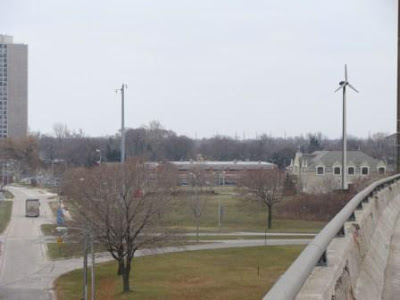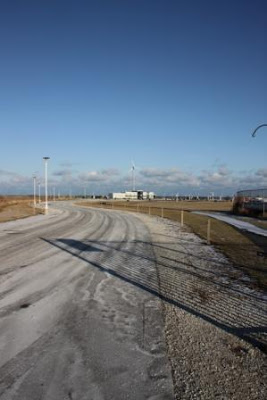by jboullion | Jan 14, 2011 | Uncategorized
From an article by Tom Content in the Milwaukee Journal Sentinel:
More than 160 people got their first glimpse Thursday of what a city wind turbine development near the Port of Milwaukee would look like.
A packed house at the South Shore Park Pavilion took a look at the renderings. Some asked questions about the project, its cost, and the noise the turbines would generate, among other concerns.
The city’s Office of Environmental Sustainability is proposing the project to make a statement in support of renewable energy and to tap greener sources of electricity for the Port of Milwaukee’s administration building.
The turbines would be either 115 or 156 feet tall, depending on the model selected. That’s less than half as tall as the utility-scale turbines built in recent years by We Energies and Invenergy in Fond du Lac and Dodge counties.
Ken Szallai, president of the Lake Express Ferry, said the city should consider making a broader statement toward sustainability that could incorporate solar power and informational exhibits, potentially at the Lake Express terminal that the city owns.
He said he shares concerns about how noisy the turbines would be, and is worried that the turbines could harm migratory birds.
“This is one of the premier places in the state to look at waterfowl and other migratory birds,” he said.
Residents at the meeting were mixed in their views. Some raised questions about whether the project is a worthwhile use of taxpayer money. The maximum project cost, $400,000, would be financed through a federal renewable-energy and energy-efficiency grant.
But that’s still taxpayer money, said Sharon Murphy, a 25-year resident of Bay View Terrace.
“That grant is a federal grant,” she said. “It’s our money!”
Bay View resident Dianne Sinnwell prompted cheers when she said she favored the plan. “We have an opportunity to be a leader in environmental clean energy, and we ought to take advantage of this opportunity,” she said.

by jboullion | Jan 13, 2011 | Uncategorized
From an article by Tom Content of the Journal Sentinel:
The city’s Office of Environmental Sustainability has released renderings of what a proposed wind turbine near the Port Administration building would look like.
Here are two views, showing one of each turbine. It’s not an apples-to-apples comparison because they are shown at two different sites, one by the port building and one closer to the lakeshore near the Lake Express ferry terminal. The renderings were prepared by the University of WIsconsin-Milwaukee Institute for Ecological Design.
The first shows the smaller turbine, a 20-kilowatt tower standing 115 feet tall. designed by Renewegy of Oshkosh, by the Port Administration building:
Below is a view of the North Power 100, built by Vermont-based Northern Power Systems, near the Lake Express terminal. It’s a 100-kilowatt turbine that would be 156 feet tall at the tip of the wind turbine blade.
A community meeting to discuss the possible placement of turbines at one of the two sites is planned for 6 p.m. Thursday at South Shore Park Pavilion.
by jboullion | Jan 12, 2011 | Uncategorized
From an article by Colleen Kottke in the Fond du Lac Reporter:
Local municipalities are profiting from the wind. While many residents in Fond du Lac and Dodge counties live nowhere near the turbines dotting the landscape, the revenue stream from the towering towers is helping to offset increases in property taxes.
Last year, owners of Wisconsin’s four largest wind energy projects paid out nearly $2.8 million in rent to landowners hosting turbines and payments in lieu of property taxes to local governments, according to figures compiled by RENEW Wisconsin, a statewide renewable energy advocacy organization.
Fond du Lac County, which is home to 166 wind turbines, received a revenue payment of $625,000. Dodge County received $296,000 in payments for hosting 85 wind turbines.
“While we didn’t designate the income for anything in particular, we did use it to pay the bills of the county. Ultimately, it saves on property tax,” said Fond du Lac County Executive Allen Buechel.
Formula
Towns and counties do not collect property taxes from wind turbines but instead receive payments based on the generating capacity of each turbine, allocated under a formula adopted by the state Legislature in 2003.
Of the total revenue paid out to local governmental entities, counties retain two-thirds of the payments while townships hosting the turbines receive one-third. Payments to those local governments in Fond du Lac and Dodge counties will reach almost $1.6 million for 2010.
Wind energy developers negotiate lease agreements with landowners to host turbines on their property. Payments can be as high as $7,000 per turbine each year. Estimated rental payments to all Fond du Lac and Dodge county landowners will total slightly more than $1.2 million for 2010. Property owners hosting the 88 wind turbines in the Blue Sky Green Field wind farm in townships of Marshfield and Calumet divvied up a total of $440,000 paid to them by WeEnergies.
Marshfield Township Chairman John Bord said the $121,000 received from WeEnergies was used to keep rising property taxes in check in the town.
by jboullion | Jan 12, 2011 | Uncategorized
From an article by Colleen Kottke in the Fond du Lac Reporter:
Local municipalities are profiting from the wind. While many residents in Fond du Lac and Dodge counties live nowhere near the turbines dotting the landscape, the revenue stream from the towering towers is helping to offset increases in property taxes.
Last year, owners of Wisconsin’s four largest wind energy projects paid out nearly $2.8 million in rent to landowners hosting turbines and payments in lieu of property taxes to local governments, according to figures compiled by RENEW Wisconsin, a statewide renewable energy advocacy organization.
Fond du Lac County, which is home to 166 wind turbines, received a revenue payment of $625,000. Dodge County received $296,000 in payments for hosting 85 wind turbines.
“While we didn’t designate the income for anything in particular, we did use it to pay the bills of the county. Ultimately, it saves on property tax,” said Fond du Lac County Executive Allen Buechel.
Formula
Towns and counties do not collect property taxes from wind turbines but instead receive payments based on the generating capacity of each turbine, allocated under a formula adopted by the state Legislature in 2003.
Of the total revenue paid out to local governmental entities, counties retain two-thirds of the payments while townships hosting the turbines receive one-third. Payments to those local governments in Fond du Lac and Dodge counties will reach almost $1.6 million for 2010.
Wind energy developers negotiate lease agreements with landowners to host turbines on their property. Payments can be as high as $7,000 per turbine each year. Estimated rental payments to all Fond du Lac and Dodge county landowners will total slightly more than $1.2 million for 2010. Property owners hosting the 88 wind turbines in the Blue Sky Green Field wind farm in townships of Marshfield and Calumet divvied up a total of $440,000 paid to them by WeEnergies.
Marshfield Township Chairman John Bord said the $121,000 received from WeEnergies was used to keep rising property taxes in check in the town.
by jboullion | Jan 12, 2011 | Uncategorized
From an article by Colleen Kottke in the Fond du Lac Reporter:
Local municipalities are profiting from the wind. While many residents in Fond du Lac and Dodge counties live nowhere near the turbines dotting the landscape, the revenue stream from the towering towers is helping to offset increases in property taxes.
Last year, owners of Wisconsin’s four largest wind energy projects paid out nearly $2.8 million in rent to landowners hosting turbines and payments in lieu of property taxes to local governments, according to figures compiled by RENEW Wisconsin, a statewide renewable energy advocacy organization.
Fond du Lac County, which is home to 166 wind turbines, received a revenue payment of $625,000. Dodge County received $296,000 in payments for hosting 85 wind turbines.
“While we didn’t designate the income for anything in particular, we did use it to pay the bills of the county. Ultimately, it saves on property tax,” said Fond du Lac County Executive Allen Buechel.
Formula
Towns and counties do not collect property taxes from wind turbines but instead receive payments based on the generating capacity of each turbine, allocated under a formula adopted by the state Legislature in 2003.
Of the total revenue paid out to local governmental entities, counties retain two-thirds of the payments while townships hosting the turbines receive one-third. Payments to those local governments in Fond du Lac and Dodge counties will reach almost $1.6 million for 2010.
Wind energy developers negotiate lease agreements with landowners to host turbines on their property. Payments can be as high as $7,000 per turbine each year. Estimated rental payments to all Fond du Lac and Dodge county landowners will total slightly more than $1.2 million for 2010. Property owners hosting the 88 wind turbines in the Blue Sky Green Field wind farm in townships of Marshfield and Calumet divvied up a total of $440,000 paid to them by WeEnergies.
Marshfield Township Chairman John Bord said the $121,000 received from WeEnergies was used to keep rising property taxes in check in the town.
by jboullion | Jan 11, 2011 | Uncategorized
From an editorial in the Milwaukee Journal Sentinel:
Wind turbines on the lakefront would be a good sign for the city’s renewable energy portfolio.
Milwaukee’s lakefront may in some ways indeed be sacred to local residents. Its natural beauty is a defining characteristic of the city and the region. But it is not so sacred that worthwhile projects can’t be developed for the lakefront.
One such project that deserves serious consideration is placing one to three wind turbines near the Lake Express car ferry terminal to provide renewable power for the Port of Milwaukee administration. It also is designed to demonstrate the city’s commitment renewable energy. These are all good things.
The project would be funded with a block grant from federal economic stimulus dollars, Erick Shambarger, a city environmental sustainability manager, told Journal Sentinel reporter Thomas Content. “No property tax dollars would be involved,” Shambarger said.
Most of the $5.8 million block grant would go to programs aimed at boosting energy efficiency and conservation, but city officials saw the wind turbine project as an opportunity “to show the city’s commitment to renewable power. Having this at the port building would be a visible way to do that,” Shambarger said.
The cost of the project would depend on the type of turbine selected. A larger turbine is expected to cost $550,000, but the price could be reduced by incentives that the city would seek from the Focus on Energy program and We Energies.


